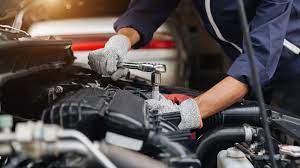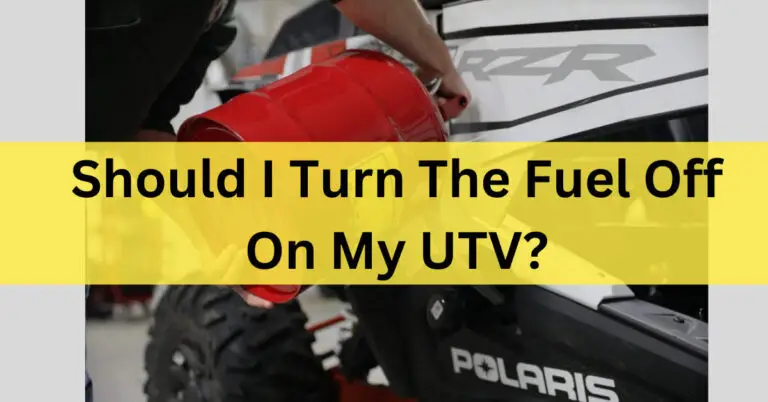UTV antifreeze blowing everywhere – Maintenance Tips In 2024
UTVs are versatile, agile, and can handle rough terrain with ease. One of the essential components of a UTV is the cooling system.
The cooling system keeps the engine from overheating, and antifreeze is a critical component of this system.
However, UTV antifreeze may sometimes start blowing everywhere, causing concerns for vehicle owners. Antifreeze blowing everywhere in your UTV can be a frustrating and potentially dangerous problem.
To fix antifreeze blowing everywhere in your UTV, you can inspect and replace the damaged components, such as the radiator cap, water pump, hoses, and thermostat.
Additionally, flushing the cooling system and checking for leaks can help prevent the issue from recurring.
When this happens, fixing the issue before it causes more significant damage to your UTV’s cooling system is essential. This article will discuss why UTV antifreeze blows everywhere and how to fix it.
Reasons Why UTV Antifreeze Blows Everywhere:
1. Failed Radiator Cap:
The radiator cap is in charge of preserving the cooling system’s pressure. If the cap fails, it can cause the antifreeze to boil, leading to excessive pressure buildup.
This buildup can cause the antifreeze to blow out from the radiator cap, resulting in a mess.
2. Clogged Radiator:
The radiator’s primary function is to remove the heat generated by the engine. Over time, the radiator can become clogged with debris, dirt, and rust.
When the radiator is clogged, it restricts the flow of antifreeze, causing it to build up pressure and blow out of the radiator.
3. Water Pump Failure:
The water pump is responsible for circulating the antifreeze throughout the engine. If the water pump fails, the antifreeze won’t circulate, causing it to build up pressure in the cooling system.
This pressure buildup can cause the antifreeze to blow out of the radiator or overflow tank.
4. Overfilled Cooling System:
Overfilling the cooling system can also cause antifreeze to blow out. When the cooling system is overfilled, there is not enough room for the antifreeze to expand when it heats up.
This expansion can cause the antifreeze to blow out of the radiator cap or overflow tank.
5. Overheating:
One of the most common reasons why UTV antifreeze blows everywhere is overheating. When the engine temperature exceeds the normal operating range, overheating occurs.
The cooling system in the UTV is designed to regulate the engine temperature, but when it fails, the engine can overheat, causing the antifreeze to boil and blow out of the overflow tank.
6. Low coolant level:
Another reason why UTV antifreeze blows everywhere is due to low coolant levels. The cooling system in the UTV requires a specific amount of coolant to function correctly.
When the coolant level is low, the cooling system cannot regulate the engine temperature, and the engine can overheat, causing the antifreeze to blow out of the overflow tank.
7. Blocked radiator or hoses:
A blocked radiator or hose can cause antifreeze to blow everywhere in a UTV. The radiator and hoses are responsible for circulating coolant through the engine to regulate its temperature.
Coolant won’t circulate correctly when they become clogged or blocked, causing the engine to overheat and antifreeze to blow out of the overflow tank.
8. Cracked or damaged hoses:
The hoses in the UTV cooling system are designed to withstand high temperatures and pressures.
However, they can crack or become damaged over time, causing coolant leaks and antifreeze to blow everywhere. Damaged hoses must be replaced immediately to prevent further coolant loss and overheating.
9. Improper antifreeze mixture:
The antifreeze mixture in the UTV cooling system must be of the correct ratio to function correctly.
If the mixture is too concentrated or too diluted, it can cause overheating and antifreeze blowing everywhere. It is essential to check the antifreeze mixture regularly and adjust it as necessary.
10. Old or worn-out thermostat:
The thermostat regulates the engine temperature by controlling the coolant flow through the engine.
It can malfunction when it becomes old or worn out, causing the engine to overheat and antifreeze to blow out of the overflow tank. The thermostat must be replaced immediately to prevent further damage to the engine.
11. Corroded cooling system components:
Corrosion can occur in the UTV cooling system, causing damage to components such as the radiator, hoses, and water pump.
Corrosion can also cause the antifreeze to break down, reducing its effectiveness in regulating the engine temperature.
Regular maintenance and flushing of the cooling system can prevent corrosion and prolong the life of the components. It is also essential to use the correct type of antifreeze to prevent corrosion and ensure the longevity of the cooling system.
Prevention and Maintenance Tips:
Here are some tips to prevent antifreeze from blowing everywhere:
1. Regular maintenance:
Regular maintenance is essential to prevent antifreeze from blowing everywhere in your UTV.
It includes checking the coolant level, flushing the cooling system, and inspecting the hoses, water pump, radiator, and thermostat for damage or wear.

2. Use the correct antifreeze:
Using the correct type of antifreeze can help prevent corrosion in the cooling system and ensure its longevity. Check your UTV owner’s manual for the recommended type of antifreeze and the correct ratio to use.
3. Check the radiator cap:
Inspect the radiator cap regularly for damage or wear. A faulty radiator cap can cause the cooling system to malfunction, leading to antifreeze blowing everywhere.
4. Check for leaks:
Inspect the cooling system for leaks regularly. Coolant leaks can lead to low coolant levels, which can cause the engine to overheat and antifreeze to blow out of the overflow tank.
5. Keep the cooling system clean:
Keeping the cooling system clean can help prevent corrosion and prolong the life of the components. Use a cooling system cleaner and follow the manufacturer’s instructions for use.
How to Fix UTV Antifreeze Blowing Everywhere:
Here are some steps you can take to fix UTV antifreeze blowing everywhere.
Step 1: Determine the Cause of the Problem:
Before attempting any repairs, you need to determine the cause of the problem. There are several reasons why antifreeze can blow everywhere in a UTV.
These include a damaged or worn-out radiator cap, a damaged water pump, a clogged or damaged hose, a faulty thermostat, or a corroded cooling system. Identifying the root cause of the problem will help you fix the issue correctly.
Step 2: Inspect the Radiator Cap:
A faulty radiator cap can cause antifreeze to blow everywhere in your UTV. The radiator cap is responsible for regulating the pressure in the cooling system.
When the cap is damaged, it can cause the pressure to increase, leading to antifreeze blowing everywhere. Look for any wear or damage on the radiator cap. If you notice any issues, replace the radiator cap with a new one.
Step 3: Inspect the Water Pump:
The engine and radiator receive coolant circulation from the water pump. A damaged water pump can cause the coolant to leak, leading to antifreeze blowing everywhere in your UTV.
Inspect the water pump for any signs of damage, such as leaks or cracks. If you notice any issues, replace the water pump with a new one.
Step 4: Inspect the Hoses:
The hoses in the UTV’s cooling system can become clogged or damaged over time, leading to antifreeze blowing everywhere.
Inspect the hoses for any signs of damage, such as cracks or leaks. If you notice any issues, replace the hoses with new ones.
Step 5: Inspect the Thermostat:
The thermostat regulates the engine temperature by controlling the coolant flow through the engine.
A faulty thermostat can cause the engine to overheat, leading to antifreeze blowing everywhere in your UTV.
Inspect the thermostat for any signs of damage or wear. If you notice any issues, replace the thermostat with a new one.
Step 6: Flush the Cooling System:
A corroded cooling system can cause antifreeze to blow everywhere in your UTV. Flushing the cooling system can help remove any build-up or debris causing the issue.
Drain the coolant from the radiator and engine block to flush the cooling system. Then, refill the system with a cleaning solution and run the engine for the recommended time. Finally, drain the cleaning solution and refill the coolant with fresh coolant.
Step 7: Check the Cooling System for Leaks:
A coolant leak in the cooling system can also cause antifreeze to blow everywhere. Check the cooling system for leaks from the radiator, hoses, or water pump. If you notice any leaks, replace the damaged components with new ones.
Step 8: Check and Adjust the Coolant Level:
The coolant level needs to be checked and adjusted to the recommended level. Overfilling the cooling system can cause antifreeze to blow out, while low coolant levels can cause overheating.
Following the manufacturer’s guidelines for checking and adjusting the coolant level is essential. Generally, the coolant level should be checked when the engine is cold and the UTV is parked on a level surface.
The coolant reservoir tank should have a minimum and maximum level indicator, and the coolant level should be between these indicators.
The reservoir tank should be topped up with the recommended coolant type and amount if the coolant level is low. It is essential to use the manufacturer’s recommended coolant type to ensure compatibility and prevent damage to the cooling system.
Step 9: Clean or Replace the Radiator:
If the radiator is clogged, it needs to be cleaned or replaced. A clogged radiator restricts the flow of antifreeze, causing it to build up pressure and blow out.
Cleaning the radiator involves flushing it with a cleaning solution while replacing it requires installing a new radiator.
Step 10: Seek Professional Help:
If you have tried the above steps and antifreeze is still blowing everywhere in your UTV, it’s time to seek professional help. A qualified mechanic can diagnose and repair the issue correctly, preventing further damage to your UTV’s cooling system.
Frequently Asked Questions:
1. How do I check for an antifreeze leak in my UTV?
To check for an antifreeze leak in your UTV, inspect the coolant reservoir, hoses, radiator, water pump, and engine block for visible signs of damage or leaks. Look for wet spots or drips, particularly around the connections and seals.
You can also use a pressure tester to pressurize the cooling system and detect leaks.
2. Is antifreeze blowing everywhere in a UTV dangerous?
Yes, antifreeze blowing everywhere in a UTV can be dangerous as it can cause the engine to overheat and potentially damage the cooling system.
3. How often should I flush the cooling system in my UTV?
The frequency of flushing the cooling system in your UTV depends on the manufacturer’s recommendations, but it’s generally recommended to flush the system every two years or every 30,000 miles.
Flushing the cooling system removes contaminants, rust, and scale buildup that can impair the system’s performance and cause leaks.
4. How do I know if my UTV is expelling antifreeze?
There are several signs that your UTV is expelling antifreeze, including a sweet smell from the engine, visible coolant leaks on the ground, and a loss of coolant in the reservoir.
You may also notice steam or smoke coming from the engine, the temperature gauge rising, or the engine overheating.
5. What type of antifreeze should I use in my UTV?
The type of antifreeze you should use in your UTV depends on the manufacturer’s specifications. Most UTVs use ethylene glycol-based antifreeze, but some manufacturers may recommend propylene glycol-based antifreeze or a specific brand.
Check your owner’s manual or contact your UTV dealer to determine the appropriate type and brand of antifreeze for your vehicle.
Conclusion:
UTV antifreeze blowing everywhere can be a frustrating and messy problem for UTV owners. The most common reasons for antifreeze blowing out are failed radiator caps, clogged radiators, water pump failure, damaged hoses, and overfilled cooling systems.
To fix this problem, UTV owners need to diagnose the underlying cause and take appropriate actions.
These actions may involve replacing faulty parts, cleaning or replacing the radiator, adjusting the coolant level, and replacing damaged hoses.
It is essential to follow the manufacturer’s guidelines for UTV maintenance and use recommended parts and coolant types to ensure optimal performance and prevent future problems.
Similar Post:






